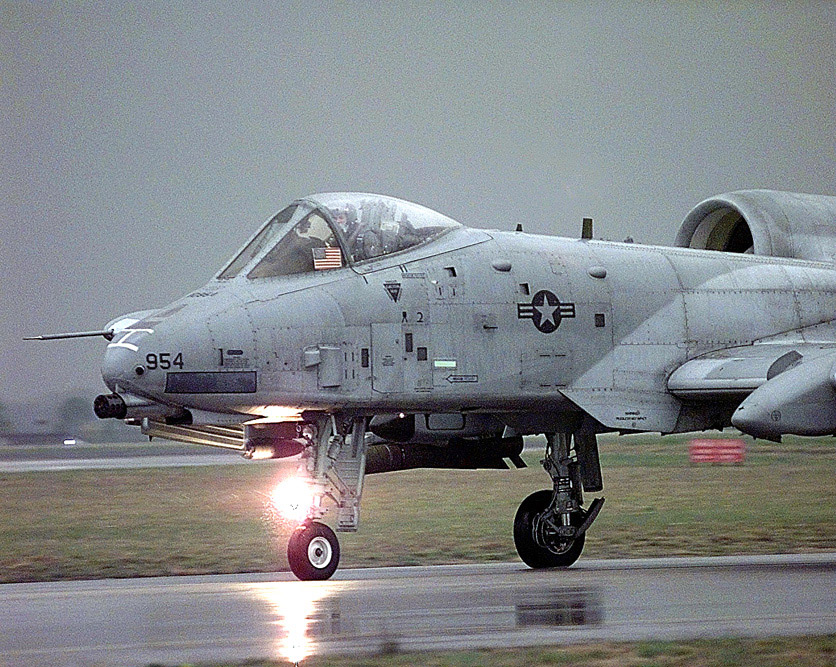A-10 Thunderbolt II
The A-10 Thunderbolt II, affectionately nicknamed "The Warthog", was developed for the United States Air Force.


Program Overview
The A-10 Thunderbolt II, affectionately nicknamed "The Warthog," was developed for the United States Air Force by the OEM Team from Fairchild Republic Company, now a part of Northrop Grumman Corporation Aeronautics Systems Eastern Region located in Bethpage NY and St. Augustine FL. Following in the footsteps of the legendary P-47 Thunderbolt, the OEM Team was awarded a study contract in the 1960s to define requirements for a new Close Air Support aircraft, rugged and survivable, to protect combat troops on the ground. This initial study was followed up by a prototype development contract for the A-X, and a final flyoff competition resulting in the selection of the A-10 Thunderbolt II.
Selection of the A-10 Thunderbolt II for this mission was based on the dramatic low altitude maneuverability, lethality, "get home safe" survivability, and mission capable maintainability designed into the jet by the OEM team. This design features a titanium "bathtub" that protects the pilot from injury, and dually redundant flight control systems that allow the pilot to fly the aircraft out of enemy range, despite severe damage such as complete loss of hydraulic capability. These features have been utilized to great effect in both the Desert Storm conflict of the 1990's and in the more recent Enduring Freedom, Iraqi Freedom, and Global War on Terror engagements.
In 1987, the A-10 OEM Team® and all A-10 assets were acquired by Grumman Corporation from Fairchild Republic Company, and are now part of the Northrop Grumman Aeronautics Systems, presently partnered with Lockheed Martin Systems Integration as a member of the A-10 Prime Team.
The OEM Team has maintained continuous involvement in the modernization of the jet, integrating the Inertial Navigation System in the 1970s, developing and installing the Low Altitude Safety and Targeting Enhancement ground collision avoidance system in the 1980s, and the Night Vision Imaging System in the 1990s, and has demonstrated particular leadership in the planning and analysis required for managing the structural integrity of the airframe through the various changes in flight maneuver spectra, mission, and force structure.
The A-10 Aircraft Structural Integrity Program began with the initial A-10 OEM development contract, with the definition of materials and processes, design analyses, component and full scale testing, and data collection and analysis on an aircraft by aircraft basis, to validate analyses and accurately predict fatigue damage for the optimization of inspection intervals and maximization of aircraft availability. The A-10 OEM Team continues to be a key member of the A-10 ASIP Team, providing loads and structures analysis, performing full scale and component testing, developing structural reinforcements and non-destructive inspection techniques to prevent structural failure, analyzing manufacturing methods for aircraft improvements and providing overall weapons system expertise for the support of the warfighter.
A-10 Thunderbolt II Specifications
Primary Function: A-10 — close air support, OA-10 - airborne forward air control
Contractor: Fairchild Republic Co. (FRC acquired in 1987, now part of Northrop Grumman ISER)
Power Plant: Two General Electric TF34-GE-1 00 turbofans
Thrust: 9,065 pounds each engine
Wingspan: 57 feet, 6 inches (17.42 meters)
Length: 53 feet, 4 inches (16.16 meters)
Height: 14 feet, 8 inches (4.42 meters)
Weight: 29,000 pounds (13,154 kilograms)
Maximum Takeoff Weight: 51,000 pounds (22,950 kilograms)
Fuel Capacity: 11,000 pounds (7,257 kilograms)
Payload: 16,000 pounds (7,257 kilograms)
Speed: 420 miles per hour (Mach 0.56)
Range: 800 miles (695 nautical miles)
Ceiling: 45,000 feet (13,636 meters)
Armament: One 30 mm GAU-8/A seven-barrel Gatling gun; up to 16,000 pounds (7,200 kilograms) of mixed ordnance on eight under-wing and three under-fuselage pylon stations, including 500 pound (225 kilograms) Mk-82 and 2,000 pounds (900 kilograms) Mk-84 series low/high drag bombs, incendiary cluster bombs, combined effects munitions, mine dispensing munitions, AGM-65 Maverick missiles and laser-guided/electro-optically guided bombs; infrared countermeasure flares; electronic countermeasure chaff; jammer pods; 2.75-inch (6.99 centimeters) rockets; illumination flares and AIM-9 Sidewinder missiles.
Crew: One
Initial Operating Capability: A-10A, 1977; A-10C, 2007
Inventory: Active force, A-10, 143 and OA-10, 70; Reserve, A-10, 46 and OA-10, 6; ANG, A-10, 84 and OA-10, 18